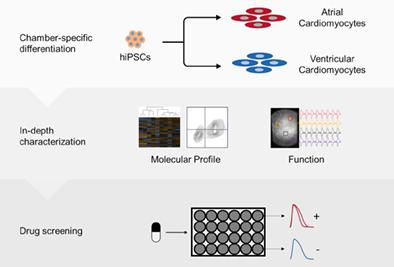当前位置:
X-MOL 学术
›
Stem Cells Transl. Med.
›
论文详情
Our official English website, www.x-mol.net, welcomes your
feedback! (Note: you will need to create a separate account there.)
Drug screening platform using human induced pluripotent stem cell-derived atrial cardiomyocytes and optical mapping.
STEM CELLS Translational Medicine ( IF 5.4 ) Pub Date : 2020-09-14 , DOI: 10.1002/sctm.19-0440 Marvin G Gunawan 1, 2 , Sarabjit S Sangha 1, 2 , Sanam Shafaattalab 1, 2, 3 , Eric Lin 1 , Danielle A Heims-Waldron 3 , Vassilios J Bezzerides 3 , Zachary Laksman 4, 5 , Glen F Tibbits 1, 2
STEM CELLS Translational Medicine ( IF 5.4 ) Pub Date : 2020-09-14 , DOI: 10.1002/sctm.19-0440 Marvin G Gunawan 1, 2 , Sarabjit S Sangha 1, 2 , Sanam Shafaattalab 1, 2, 3 , Eric Lin 1 , Danielle A Heims-Waldron 3 , Vassilios J Bezzerides 3 , Zachary Laksman 4, 5 , Glen F Tibbits 1, 2
Affiliation

|
Current drug development efforts for the treatment of atrial fibrillation are hampered by the fact that many preclinical models have been unsuccessful in reproducing human cardiac physiology and its response to medications. In this study, we demonstrated an approach using human induced pluripotent stem cell‐derived atrial and ventricular cardiomyocytes (hiPSC‐aCMs and hiPSC‐vCMs, respectively) coupled with a sophisticated optical mapping system for drug screening of atrial‐selective compounds in vitro. We optimized differentiation of hiPSC‐aCMs by modulating the WNT and retinoid signaling pathways. Characterization of the transcriptome and proteome revealed that retinoic acid pushes the differentiation process into the atrial lineage and generated hiPSC‐aCMs. Functional characterization using optical mapping showed that hiPSC‐aCMs have shorter action potential durations and faster Ca2+ handling dynamics compared with hiPSC‐vCMs. Furthermore, pharmacological investigation of hiPSC‐aCMs captured atrial‐selective effects by displaying greater sensitivity to atrial‐selective compounds 4‐aminopyridine, AVE0118, UCL1684, and vernakalant when compared with hiPSC‐vCMs. These results established that a model system incorporating hiPSC‐aCMs combined with optical mapping is well‐suited for preclinical drug screening of novel and targeted atrial selective compounds.
中文翻译:

使用人诱导多能干细胞衍生的心房心肌细胞和光学映射的药物筛选平台。
当前用于治疗心房颤动的药物开发工作受到以下事实的阻碍:许多临床前模型未能成功复制人类心脏生理学及其对药物的反应。在这项研究中,我们展示了一种使用人诱导多能干细胞衍生的心房和心室心肌细胞(分别为 hiPSC-aCM 和 hiPSC-vCM)与复杂的光学绘图系统相结合的方法,用于体外心房选择性化合物的药物筛选。我们通过调节 WNT 和类视黄醇信号通路优化了 hiPSC-aCM 的分化。转录组和蛋白质组的表征表明,视黄酸将分化过程推入心房谱系并产生 hiPSC-aCM。与 hiPSC-vCM 相比,2 +处理动力学。此外,与 hiPSC-vCM 相比,hiPSC-aCM 的药理学研究通过显示对心房选择性化合物 4-氨基吡啶、AVE0118、UCL1684 和维纳卡兰更高的敏感性来捕获心房选择性作用。这些结果表明,结合 hiPSC-aCM 与光学映射的模型系统非常适合于新的靶向心房选择性化合物的临床前药物筛选。
更新日期:2020-09-14
中文翻译:

使用人诱导多能干细胞衍生的心房心肌细胞和光学映射的药物筛选平台。
当前用于治疗心房颤动的药物开发工作受到以下事实的阻碍:许多临床前模型未能成功复制人类心脏生理学及其对药物的反应。在这项研究中,我们展示了一种使用人诱导多能干细胞衍生的心房和心室心肌细胞(分别为 hiPSC-aCM 和 hiPSC-vCM)与复杂的光学绘图系统相结合的方法,用于体外心房选择性化合物的药物筛选。我们通过调节 WNT 和类视黄醇信号通路优化了 hiPSC-aCM 的分化。转录组和蛋白质组的表征表明,视黄酸将分化过程推入心房谱系并产生 hiPSC-aCM。与 hiPSC-vCM 相比,2 +处理动力学。此外,与 hiPSC-vCM 相比,hiPSC-aCM 的药理学研究通过显示对心房选择性化合物 4-氨基吡啶、AVE0118、UCL1684 和维纳卡兰更高的敏感性来捕获心房选择性作用。这些结果表明,结合 hiPSC-aCM 与光学映射的模型系统非常适合于新的靶向心房选择性化合物的临床前药物筛选。











































 京公网安备 11010802027423号
京公网安备 11010802027423号